As an Amazon Associate KitchenwareSets.com earns from qualifying purchases.
11 Essential Japanese Kitchen Tools You Need To Master Cooking
Japanese cuisine is a beautiful art form, balancing delicate flavors, precise techniques, and mindful presentation. Have you ever marveled at a perfectly crafted sushi roll or a comforting bowl of ramen and thought, “I wish I could make that at home”? You’re not alone. The desire to recreate these authentic dishes is strong, but it’s often met with a sense of intimidation.
Walking through the aisles of a Japanese market or browsing online can feel overwhelming. You see dozens of specialized pots, unfamiliar utensils, and unique gadgets. It’s easy to wonder which tools are truly essential and which are just for professional chefs. This uncertainty can stop you before you even start, leaving you to believe that mastering Japanese cooking is simply out of reach for the home cook.
The secret to mastering Japanese cooking lies in a few key tools designed for precision and flavor. This guide covers the 11 essential items, from a perfect rice cooker to specialized knives, that will elevate your home cooking and help you create authentic dishes. By focusing on these foundational tools, you can transform your kitchen and turn that feeling of intimidation into one of confident, joyful creation.
Want to Cook Authentic Japanese Food But Don’t Know Where to Start?
Starting your journey into Japanese cooking is an exciting adventure, but the secret to success lies in having a few key tools designed for precision and flavor. Japanese cuisine values efficiency, simplicity, and getting the most out of every ingredient. The right cookware isn’t about having a gadget for every single task; it’s about having versatile, high-quality essentials that make fundamental techniques like simmering dashi, getting perfectly fluffy rice, and making precise cuts feel effortless. This guide is your simple roadmap to the 11 foundational tools that will make the biggest difference, transforming your cooking from intimidating to absolutely achievable.
11 Essential Japanese Kitchen Tools to Master Cooking (2025 Update)
The essential Japanese kitchen tools include a high-quality rice cooker, a versatile Japanese knife (Hōchō), a Suribachi (mortar & pestle), long cooking chopsticks (Saibashi), and a Hangiri (sushi rice tub), among others. Mastering these core items is the key to unlocking the authentic flavors, textures, and techniques that define Japanese cuisine. This curated list, based on the wisdom of seasoned home cooks and culinary experts, will walk you through each must-have tool, explaining exactly why it deserves a place in your kitchen.
1. The Indispensable Rice Cooker (Suihanki)
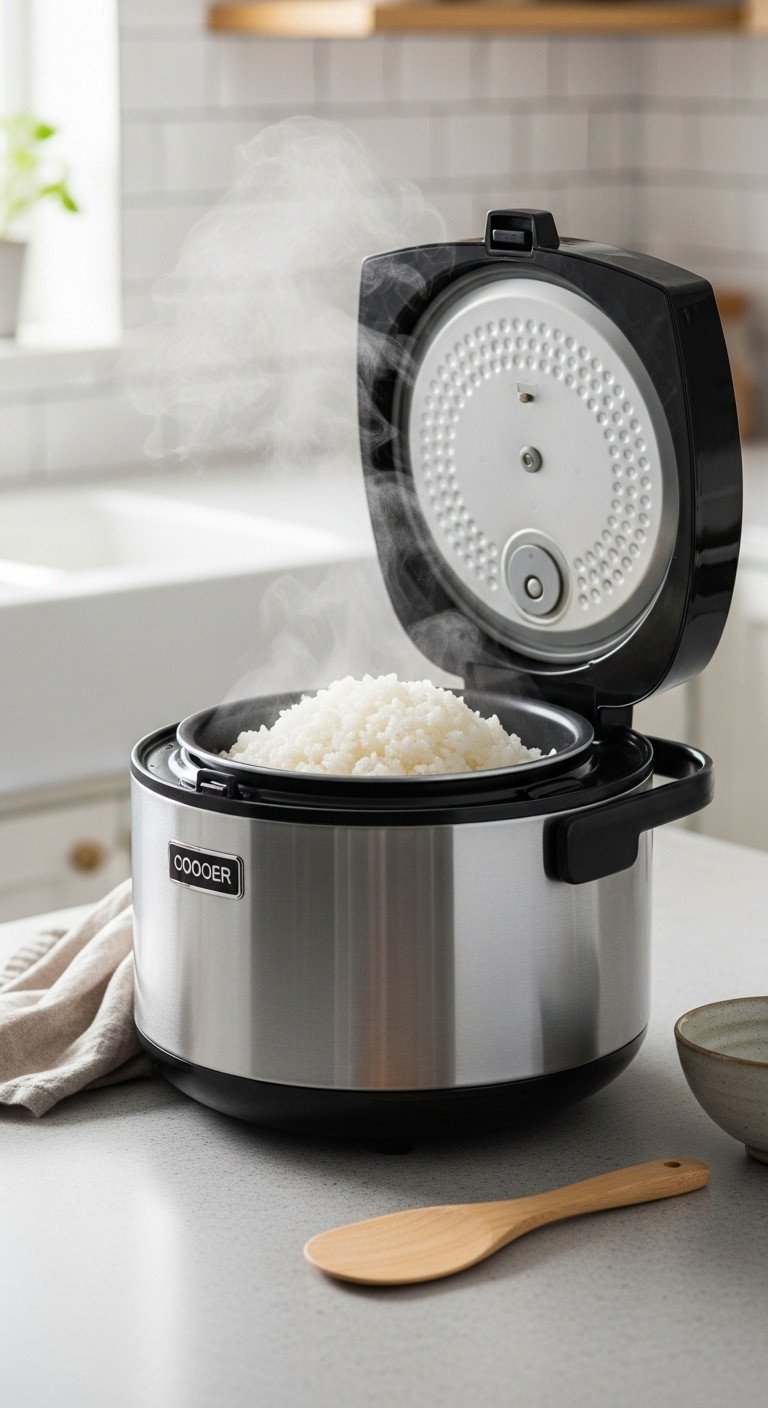
A quality Japanese rice cooker is the cornerstone of the Japanese kitchen because it delivers perfectly fluffy, consistent rice every single time.
Why It’s Essential:
* Consistency: A quality Japanese rice cooker automatically adjusts temperature and time to produce perfectly fluffy, never mushy, rice every single time.
* Versatility: Modern units are multi-cookers, capable of making porridge (okayu), steaming vegetables, and even baking cakes.
* Convenience: The “keep warm” function is a staple in Japanese households, ensuring hot rice is ready for hours. For the best results, look for a model with Induction Heating (IH) and “fuzzy logic” technology, which makes micro-adjustments for flawless texture.
Pro-Tip: Always rinse your rice in cold water until the water runs mostly clear before cooking. This removes excess starch and prevents the rice from becoming gummy.
Call to Action (CTA): Pin this essential appliance to your “Dream Kitchen” board!
2. Precision Japanese Knives (Hōchō) & Cutting Board
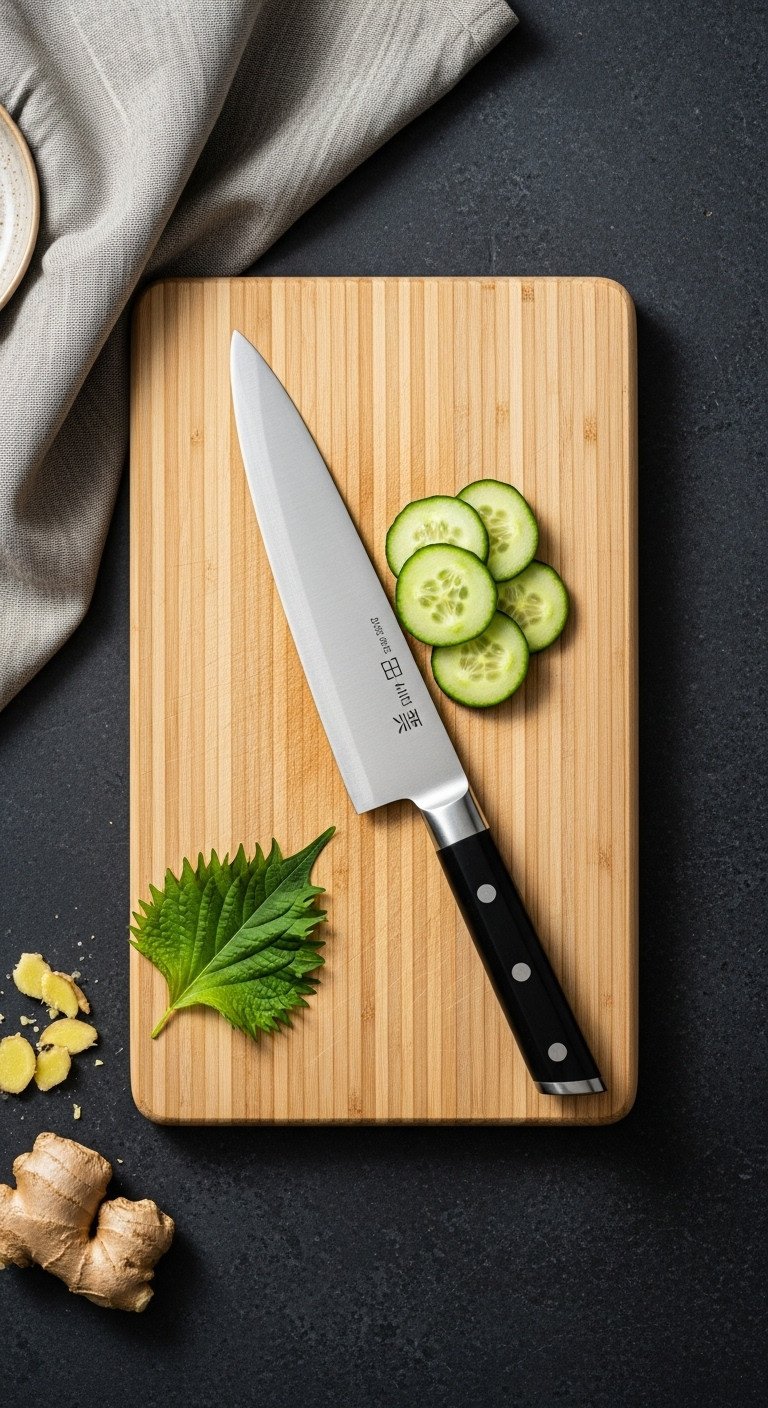
A sharp Japanese knife is essential as it allows for the incredibly thin, precise cuts that are fundamental to Japanese cooking and preserving the texture of ingredients.
Why It’s Essential:
* Santoku: The perfect starter knife, its name means “three virtues” (slicing, dicing, mincing). Ideal for everyday tasks.
* Gyuto: The Japanese equivalent of a Western chef’s knife, great for general-purpose work and rock-chopping.
* Precision: Japanese knives are known for their harder steel and sharper edge angle, allowing for incredibly thin, precise cuts that preserve the texture of ingredients.
* Hinoki Cutting Board: To protect your investment, pair it with a Hinoki (Japanese cypress) board. This soft wood is gentle on the blade’s edge and is naturally antibacterial.
Pro-Tip: Never put a high-quality Japanese knife in the dishwasher. Always wash and dry it by hand immediately after use to prevent rust and damage to the handle.
Call to Action (CTA): Save this beautiful knife set to your “Culinary Tools” board!
3. The Grinding Suribachi & Surikogi (Mortar & Pestle)
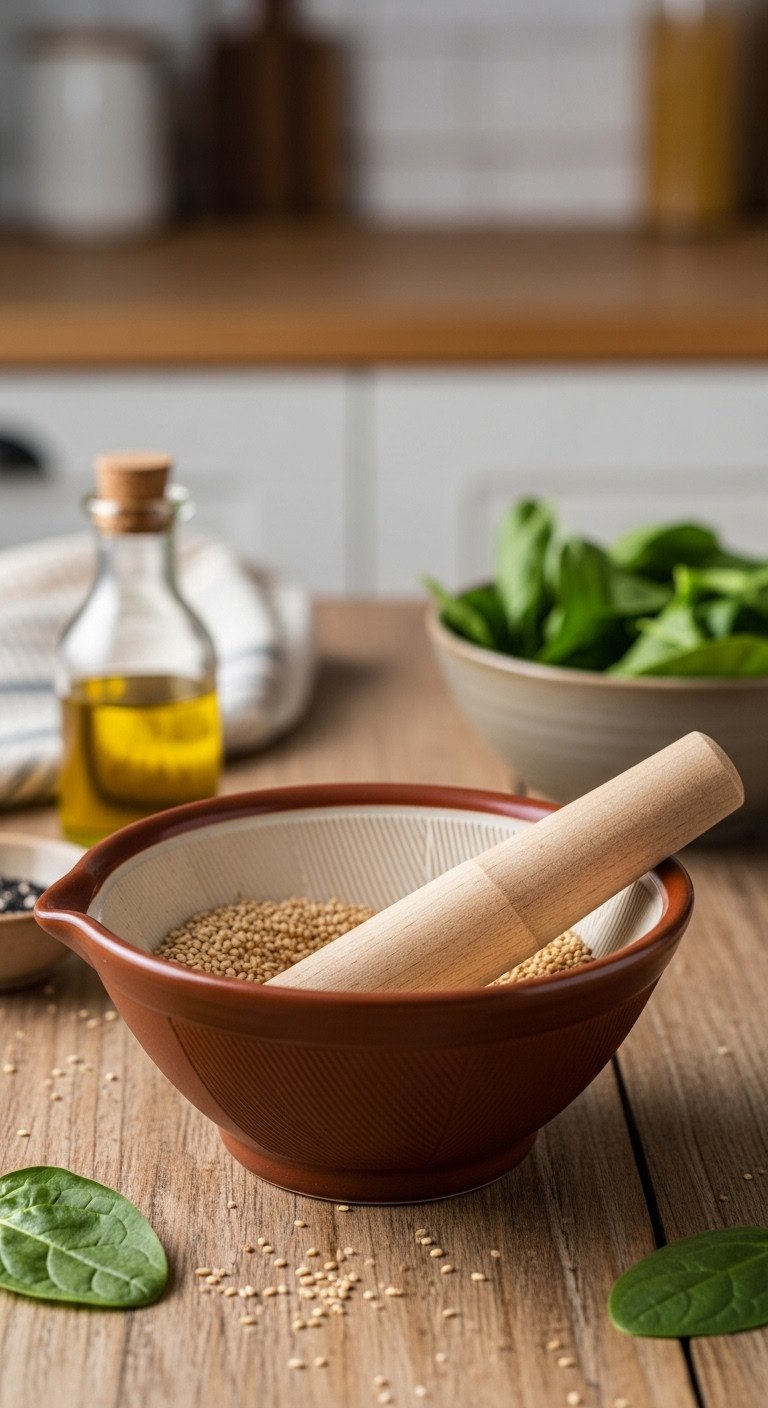
A suribachi and surikogi are crucial for efficiently grinding ingredients like sesame seeds to release their maximum aroma and flavor for dressings and pastes.
Why It’s Essential:
* Efficient Grinding: The sharp, unglazed grooves (kushinome) inside the bowl grip ingredients like sesame seeds, making grinding fast and efficient.
* Flavor Release: It’s perfect for making pastes and dressings from scratch, releasing incredible aromas and flavors you can’t get from pre-ground spices.
* Key Dishes: Essential for making goma-ae (sesame dressings for vegetables) and grinding spices for marinades.
Pro-Tip: After use, clean the suribachi with a stiff brush (like a tawashi) and hot water to dislodge particles from the grooves without using soap, which can be absorbed by the ceramic.
Call to Action (CTA): Love fresh flavors? Save this traditional tool to your “Kitchen Gadgets” board!
4. Versatile Long Cooking Chopsticks (Saibashi)
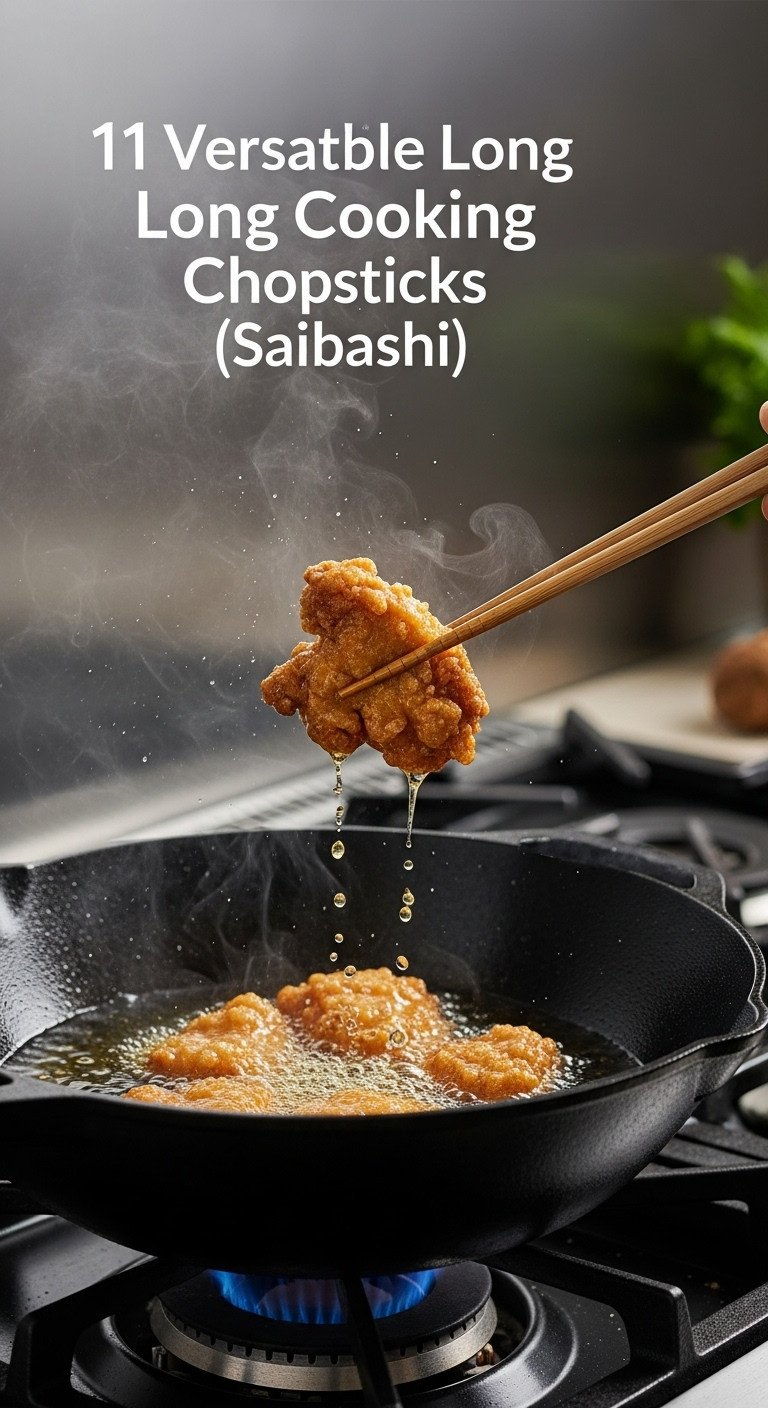
Saibashi are indispensable because they act as a safe and precise extension of your fingers, perfect for everything from deep-frying to delicate plating.
Why It’s Essential:
* Safety: Their length (typically 30cm or more) keeps your hands safely away from hot oil when deep-frying or stir-frying.
* Precision: They act as an extension of your fingers, allowing for delicate tasks like turning small pieces of food, whisking eggs, and artful plating.
* Multipurpose: Use them to scramble eggs, test noodle doneness, mix sauces, and handle delicate ingredients without crushing them. Many cooks prefer bamboo or wood saibashi for their superior grip.
Pro-Tip: Keep a dedicated pair for raw meat and another for cooked food/vegetables to prevent cross-contamination, just as you would with cutting boards.
Call to Action (CTA): Pin this must-have utensil to your “Japanese Cooking” board!
5. The Perfect Sushi Rice Tub (Hangiri)
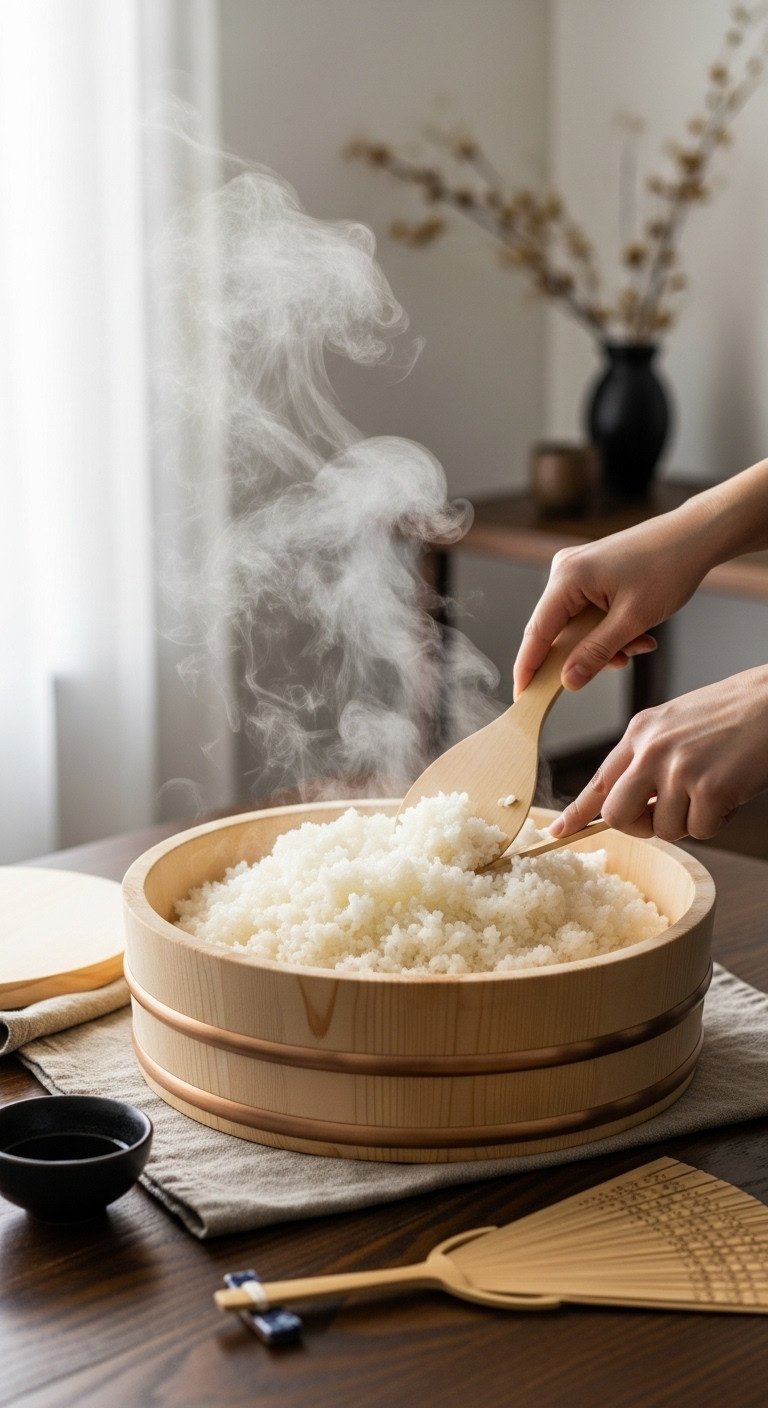
A hangiri is essential for making authentic sushi because its large, wooden surface absorbs excess moisture, giving the rice the perfect al dente texture.
Why It’s Essential:
* Moisture Absorption: The large, flat surface area and the unfinished wood (typically cypress or pine) work together to absorb excess moisture from the cooked rice as it cools.
* Perfect Texture: This process prevents the rice from becoming gummy and allows it to achieve the perfect al dente texture required for sushi.
* Even Seasoning: The shallow bowl makes it easy to fold in the sushi vinegar seasoning evenly without mashing the delicate grains of rice.
Pro-Tip: Before first use (and occasionally thereafter), season your hangiri by filling it with water and a few tablespoons of rice vinegar. Let it sit for a few hours, then rinse and air dry completely. This helps prevent leaks and reduces the wood smell.
Call to Action (CTA): Planning a sushi night? Pin this essential tool now!
6. The Sushi Rolling Mat (Makisu)
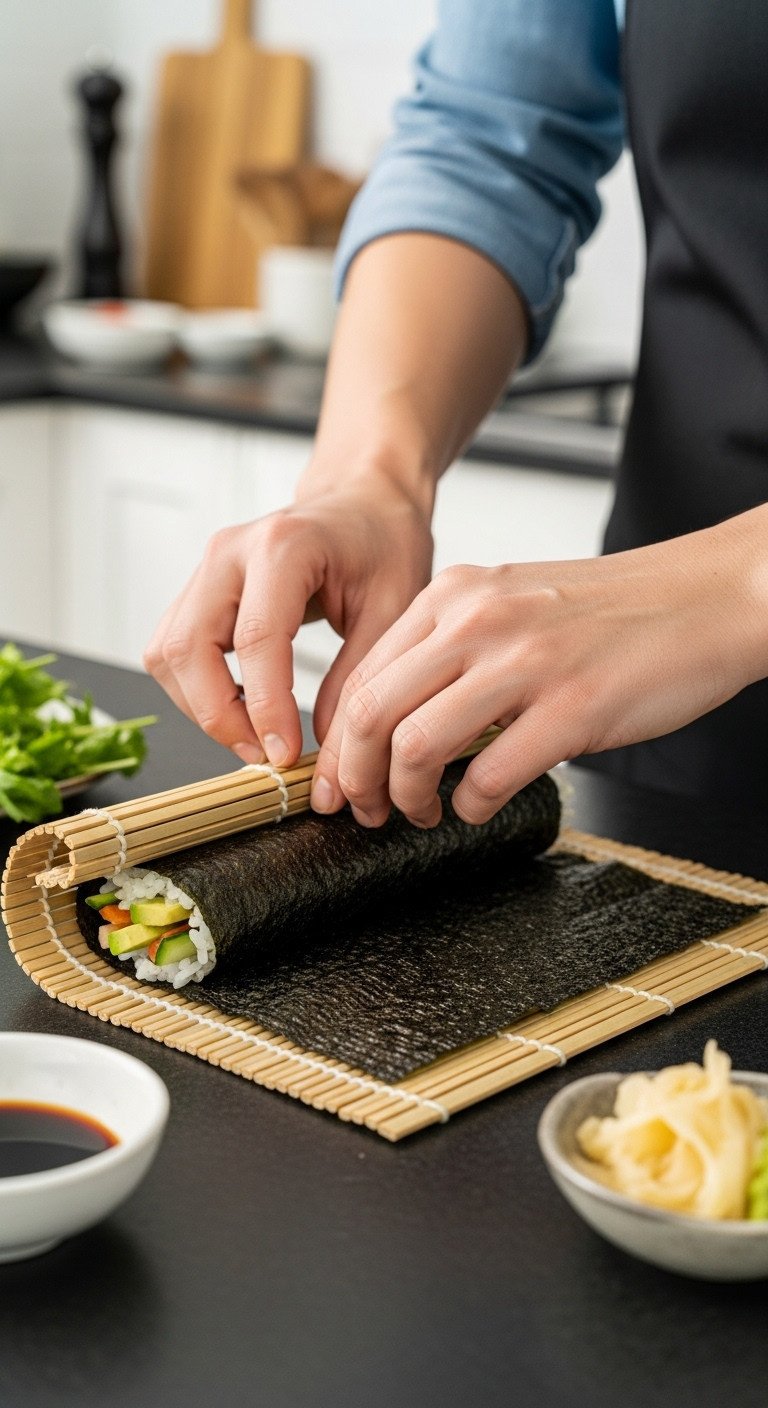
The makisu is the simple, inexpensive key to creating tight, uniform maki sushi rolls without crushing the delicate fillings.
Why It’s Essential:
* Uniform Rolls: This simple mat of woven bamboo sticks is the key to creating tight, uniform maki sushi rolls without crushing the ingredients.
* Shaping: It’s also used to shape other foods, most notably tamagoyaki (Japanese rolled omelet), giving it its characteristic rectangular log shape.
* Affordable & Easy: Makisu are inexpensive, easy to clean, and essential for anyone serious about making sushi at home. A quality mat will have sticks that are flat on one side and rounded on the other for versatility.
Pro-Tip: To keep your makisu clean and prevent rice from sticking, wrap it in a layer of plastic wrap before you start rolling. This makes cleanup a breeze.
Call to Action (CTA): Add this simple tool to your “DIY Sushi Night” inspiration board!
7. The Broth-Perfecting Fine Mesh Skimmer (Aku Tori)
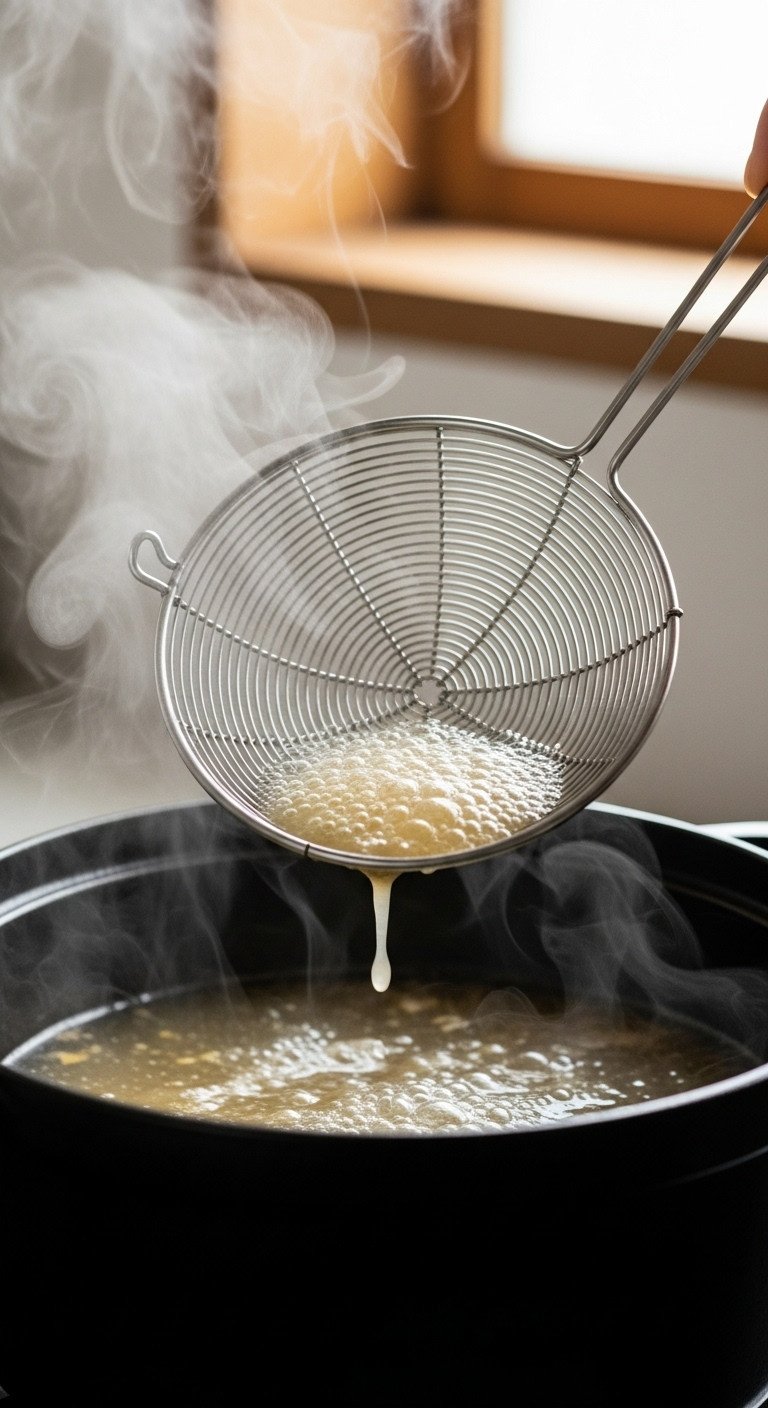
A fine mesh skimmer is vital for removing the scum and foam (“aku”) from broths and soups, resulting in a cleaner taste and clearer appearance.
Why It’s Essential:
* Clarity and Flavor: Japanese cuisine values clear, clean-tasting broths (dashi) and soups. This tool is specifically designed to remove the “aku” – the scum, foam, and excess fat that rises to the surface during cooking.
* Refined Taste: Removing these impurities results in a lighter, more refined flavor and a more appealing appearance in dishes like nabe (hot pot) and sukiyaki.
* Frying Aid: It’s also perfect for fishing out small bits of fried tempura batter (tenkasu) from hot oil to keep it clean.
Pro-Tip: Keep a small bowl of water next to your pot. After each skim, dip the skimmer in the water to easily rinse off the collected scum before skimming again.
Call to Action (CTA): For crystal clear soups, pin this secret weapon to your “Cooking Tips” board!
8. The Silky-Smooth Miso Strainer & Muddler
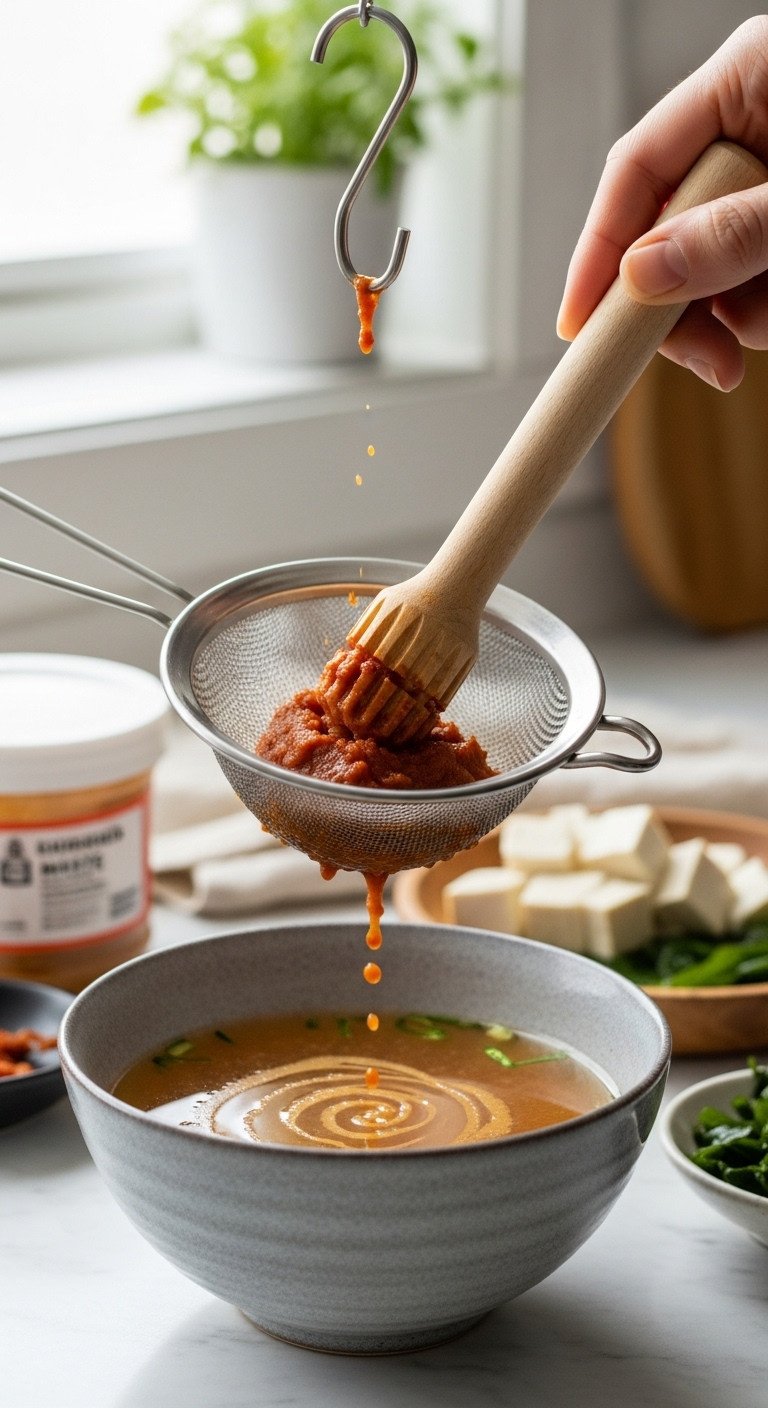
A miso strainer is the easiest way to achieve perfectly smooth, clump-free miso soup every time.
Why It’s Essential:
* Clump-Free Soup: Miso paste can be clumpy and difficult to dissolve directly in a pot. This tool solves that problem perfectly.
* Smooth Consistency: Simply place a scoop of miso in the strainer, lower it into your dashi broth, and use the muddler (or chopsticks) to gently press and stir the paste until it dissolves completely through the mesh.
* Perfect Flavor: This method ensures every spoonful of your miso soup is silky smooth and consistently flavored. Many miso strainers come with a hook to rest on the side of the pot for easy use.
Pro-Tip: Always add the miso at the very end of cooking, with the heat turned off. Boiling miso can diminish its delicate flavor and aroma and kill its beneficial probiotics.
Call to Action (CTA): Elevate your miso soup! Pin this clever tool to your “Kitchen Hacks” board!
9. The Fine & Fluffy Ceramic Grater (Oroshigane)
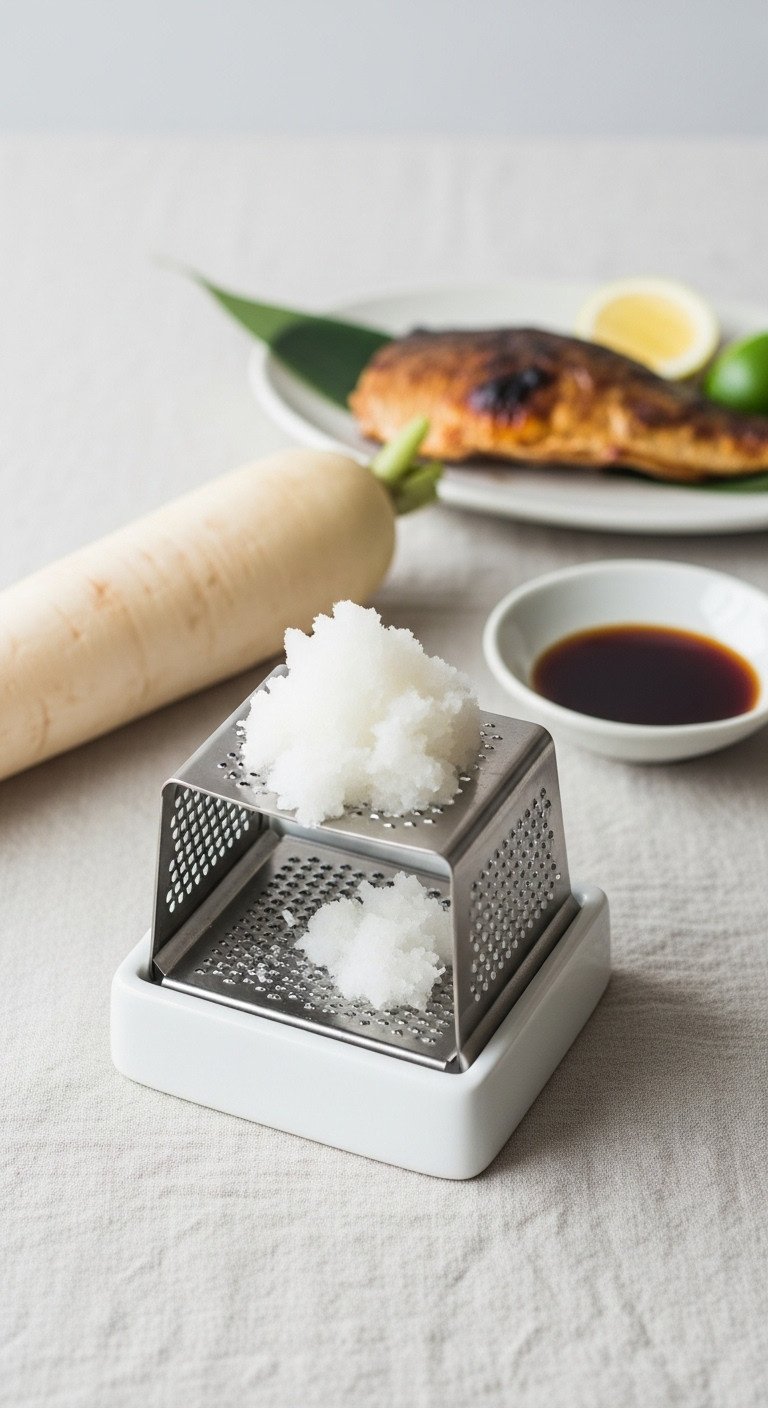
A ceramic oroshigane is used to mash ingredients like ginger and daikon into a fine, fluffy paste, releasing more flavor than a traditional shredding grater.
Why It’s Essential:
* Unique Texture: Unlike sharp metal graters that shred, the fine ceramic teeth mash ingredients like ginger, garlic, and daikon radish into a very fine, almost wet and fluffy paste.
* Flavor Infusion: This texture allows the flavors to meld beautifully into dipping sauces, marinades, and soups.
* Practical Design: Many versions feature a moat around the edge to conveniently collect the flavorful juices that are released during grating. The silicone base on some models prevents slipping.
Pro-Tip: For the best results with fibrous ingredients like ginger, grate in a circular motion. This helps break down the fibers more effectively for a smoother paste.
Call to Action (CTA): Get the perfect texture for your garnishes. Save this grater idea!
10. The Communal Earthenware Hot Pot (Donabe)
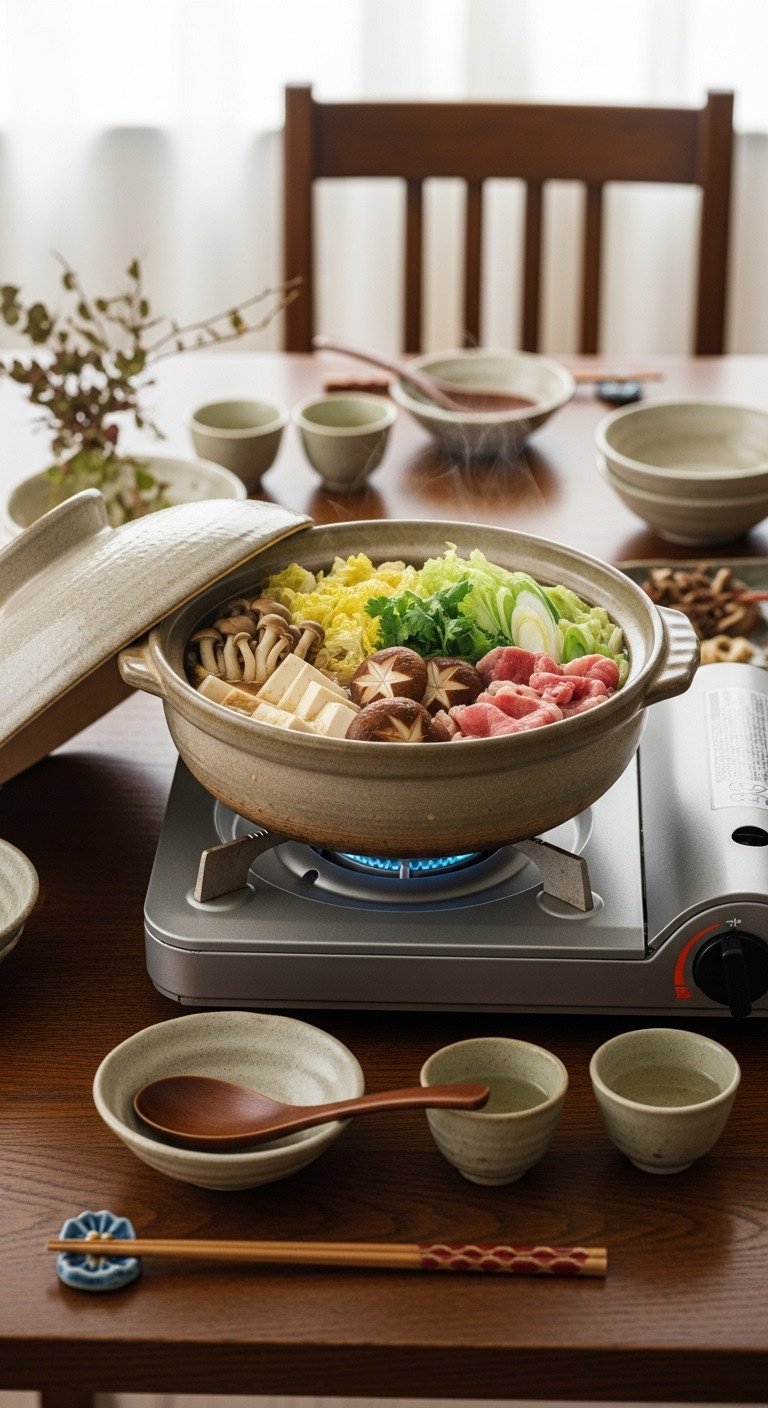
A donabe is the centerpiece for communal meals, valued for its superior heat retention which develops deep, complex flavors in slow-cooked soups and stews.
Why It’s Essential:
* Superior Heat Retention: Made from special heat-resistant clay, donabe pots heat up slowly and evenly, and they retain heat long after being removed from the stove.
* Flavor Enhancement: The gentle, even heat is perfect for slow-cooking stews and soups, developing deep, complex flavors.
* Communal Dining: Donabe are the centerpiece of “nabe” (hot pot) meals, where diners cook ingredients together at the table. They are perfect for shabu-shabu, sukiyaki, and chanko nabe.
Pro-Tip: Before its first use, you must “season” a new donabe by making a simple rice porridge (okayu) in it. This fills the porous clay’s microscopic pores and prevents cracks and leaks.
Call to Action (CTA): Plan a cozy hot pot night! Pin this beautiful donabe for inspiration.
11. The Everyday Simmering Pot (Yukihira Nabe)
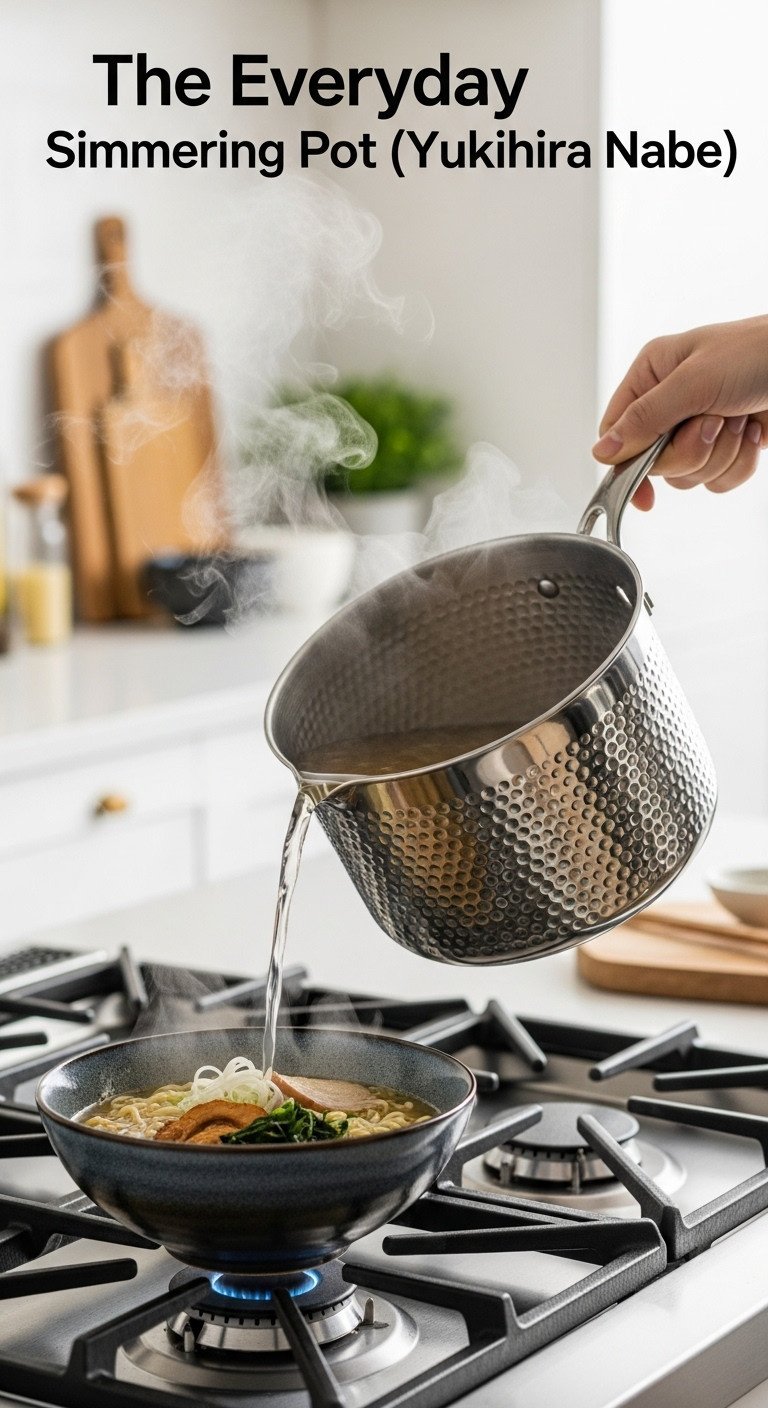
The Yukihira nabe is the everyday workhorse pot, ideal for its lightweight design that heats up quickly for making dashi, soups, and simmered dishes.
Why It’s Essential:
* Lightweight & Fast: These pots are typically made of thin, hammered stainless steel or aluminum, allowing them to heat up very quickly.
* Practical Design: The hammered surface (tsuchime) increases durability and surface area for faster heating. Most have pour spouts on both sides, making them convenient for both right- and left-handed cooks.
* Everyday Workhorse: This is the go-to pot in a Japanese kitchen for making dashi, miso soup, simmered vegetables (nimono), and blanching greens. Look for a model with internal measurement markings for added convenience.
Pro-Tip: While Yukihira pots are durable, they are not meant for high-heat searing or deep-frying. Use them primarily for boiling, simmering, and making broths.
Call to Action (CTA): Discover your new favorite saucepan! Pin this versatile Yukihira pot.
Key Takeaways: Your Quick Guide to Japanese Kitchen Essentials
Feeling ready to build your collection? Here’s a quick summary of where to start based on your cooking goals.
- For Everyday Basics: A quality Rice Cooker and a versatile Santoku Knife are non-negotiable.
- For Soups & Broths: A Yukihira Nabe for quick heating and a Fine Mesh Skimmer for clarity are a perfect pair.
- For Authentic Flavor: A Suribachi (mortar & pestle) unlocks incredible flavor from seeds and spices.
- For Making Sushi: A Hangiri (rice tub) and Makisu (rolling mat) are essential for achieving the right texture and shape.
- Most Versatile Utensil: Saibashi (long chopsticks) will quickly become the tool you reach for constantly.
People Also Ask About Japanese Kitchen Essentials
What is the single most important tool for Japanese cooking?
While a rice cooker is vital, the single most important tool is a high-quality Japanese knife (hōchō), such as a Santoku or Gyuto. Proper knife work and precise cuts are foundational to Japanese cuisine, affecting both the texture and presentation of nearly every dish.
Can I make good Japanese rice without a rice cooker?
Yes, you can make rice on the stovetop, but a dedicated Japanese rice cooker provides far superior consistency and convenience. It automates the process to ensure perfectly fluffy, non-gummy rice every time and keeps it warm for hours, a staple feature in Japanese homes.
What are some “fun” but useful Japanese kitchen gadgets for gifts?
Great gift ideas that are both fun and useful include a Taiyaki pan for fish-shaped cakes, a Takoyaki pan for octopus balls, or an Onigiri mold for perfectly shaped rice balls. These tools make popular Japanese snacks accessible and enjoyable to prepare at home.
Final Thoughts
Building an authentic Japanese kitchen doesn’t have to happen overnight. You don’t need to buy all 11 of these tools at once. The best approach is to start with the items that will have the biggest impact on the dishes you’re most excited to cook. Begin with a fantastic knife and a reliable rice cooker. As your skills grow and you explore new recipes, you can gradually add tools like a suribachi or a donabe to your collection. The journey is part of the joy.
Which of these Japanese kitchen tools are you most excited to try first? Let me know in the comments below
Last update on 2025-10-14 at 22:33 / Affiliate links / Images from Amazon Product Advertising API
